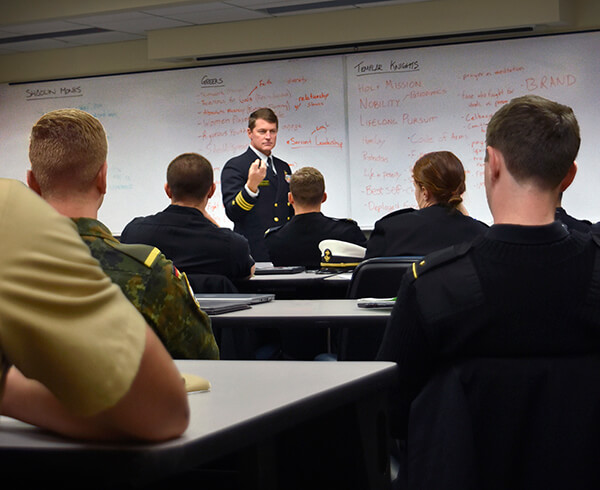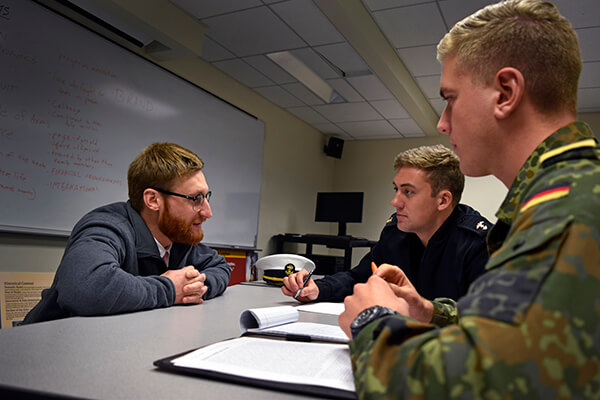The Code of the Warrior
 In a windowless room tucked into a corner of Luce Hall at the end of the fall 2018 semester, Commander Andrew Ledford ’95, USN, associate chair of Leadership, Ethics and Law at the Naval Academy, divided his class into groups for “speed-warrioring.”
In a windowless room tucked into a corner of Luce Hall at the end of the fall 2018 semester, Commander Andrew Ledford ’95, USN, associate chair of Leadership, Ethics and Law at the Naval Academy, divided his class into groups for “speed-warrioring.”
“I want you to think about the key warrior elements for each of these seven clans that make them unique,” said Ledford. “I want your groups to be broken up by the communities that you hope to aspire to go into. The Sioux, let’s start with the Marines. It should be easy to figure out who the Marines are in this group. Aviators will go with Samurai, SEALs will be on the Roman Legion, TADs are on Templar Knights … ”
Groups of midshipmen began feverishly brainstorming about the cultural significance and traits of 5,000 years of warrior tribes like the Zulu, physically disparate and centuries apart, like Native Americans and ancient Romans. As the conversations ramped up, it became clear to the midshipmen that these cultures shared more than they expected, concepts like standing armies, extreme training, empowered women, death over disgrace, being defined by weapon and not uniform, honoring the dead and more.
They presented their findings and connected them to their service selection, like the Templar Knights believing they were nothing without their horses, “like a pilot without a plane,” one midshipman realized. The instructors beamed—the “Code of the Warrior” class was working.
The course features two-week modules on seven warrior cultures: the Sioux, Zulu, Samurai, Roman Legion, Shaolin Monks, Greeks and Templar Knights. “Breaking it down by cultures is powerful,” said lead instructor Ledford, who spent nearly two decades as a SEAL. “By emphasizing these types of traits by culture, we can really cover a lot of material. Concepts like honor are broken into smaller pieces this way and are woven through time and history.” Each module covers the historical context of the warrior culture, how the society created their warriors, the code of that warrior clan and the consequences of breaking that code.
 The class, initially developed by former philosophy professor Shannon French, Ph.D., author of the book The Code of the Warrior, and then taught for several years by Dr. Joseph J. Thomas, now director of the Stockdale Center, furthers the Academy’s mission of shaping the leaders of tomorrow by diving deep into the warriors of the past with a team of present-day role models as instructors. The 2018 instructors assembled by Ledford included Lieutenant Brad Snyder ’06, USN (Ret.), an explosive ordnance disposal officer, and the Captain Nicholas Vogt, USA, USMA ’10 Combat Veteran Faculty Intern, who lost his sight in Afghanistan due to an improvised explosive device; Major Lee Shinn ’04, USMC, an infantry officer; Lieutenant Commander Sam Blair, USN, the Academy’s SEAL program director; and Chief Petty Officer Dan Luna, USN, also a SEAL. The instructors are there to teach as well as inject sea stories and advice, which one midshipman called “a once-in-a-lifetime opportunity.”
The class, initially developed by former philosophy professor Shannon French, Ph.D., author of the book The Code of the Warrior, and then taught for several years by Dr. Joseph J. Thomas, now director of the Stockdale Center, furthers the Academy’s mission of shaping the leaders of tomorrow by diving deep into the warriors of the past with a team of present-day role models as instructors. The 2018 instructors assembled by Ledford included Lieutenant Brad Snyder ’06, USN (Ret.), an explosive ordnance disposal officer, and the Captain Nicholas Vogt, USA, USMA ’10 Combat Veteran Faculty Intern, who lost his sight in Afghanistan due to an improvised explosive device; Major Lee Shinn ’04, USMC, an infantry officer; Lieutenant Commander Sam Blair, USN, the Academy’s SEAL program director; and Chief Petty Officer Dan Luna, USN, also a SEAL. The instructors are there to teach as well as inject sea stories and advice, which one midshipman called “a once-in-a-lifetime opportunity.”
While studying the Greeks, Snyder asked the midshipmen, “Do you measure the warrior by the level of their lethality?” and, “You need to find your inner lion, but what’s problematic with that … coming back from it?” He offered the real-world example of Staff Sergeant Robert Bales, an Army soldier in Afghanistan who killed 16 civilians, seven of them children, in what is known as the Kandahar Massacre.
During the classroom session, a group of future Marines reporting on the Sioux saw that “it was all about honor and respect on the battlefield … it wasn’t all about killing. It resembled a fight more than a war.” The question about lethality asked at the beginning of the semester continued to be answered all the way through to the end.
Midshipman John Conley ’19, an operations research major with a love of history, is a soon-to-be Marine who took the class to gain perspective on concepts that could be important in his future with the Marine Corps. He also received a new perspective about the brutality of combat through the class’ blunt and philosophical conversations.
“I also thought a lot about how a warrior culture can take elements too far,” Conley said. “The Japanese obsession with bushido, honor and the supremacy of the Japanese warrior culture gave rise to the national attitude that led to World War II. The Spartans put so much emphasis on the competency of their individual warrior but never developed the economic, logistic, political or cultural infrastructures to dominate Greece for a significant period of time, let alone most of the known world, like the Romans did.”
After the groups presented, Ledford asked them to reconvene according to their service selection and revisit each warrior class from the perspective of their future communities.
“What warrior clans are personified in that community?” he asked. “What key characteristics from which clans are personified in that community? Instructors, if there is anything else you can add from your experience, jump in as we talk about these communities.”
Protectors, self-mastery, rites of passage, tradition, brand perspective, winning battles as a group, resocialization … the midshipmen made the connections as the instructors rotated through the groups and encouraged more ideas. Ledford, a Marine infantry officer before becoming a SEAL, stopped a conversation between the future Marines to recommend they read Making the Corps, a book that addresses the separation they will likely feel during their initial Marine training and how they will view their friends, home and themselves through the Marine Corps prism.
“Read this before you go to TBS [The Basic School],” he said. “You will look back at who you were as a midshipman with a new set of eyes. ‘How the hell was I like that? What was I thinking?’ It’s going to change you forever and you’re never going to be the same.”
Conley had no problem seeing the parallels between the Roman Legion and the Marine Corps. “The Romans were an expeditionary fighting force that was led by the example of the Centurions and found success due to their superior discipline and aggression,” he said. “The Marine Corps has a massive focus on aggressively closing with and destroying the enemy, which is much like how the Romans intentionally closed with their enemy quickly and violently to break the enemy’s less disciplined formation.”
Many of the students remark in their opinion forms that “The Code of the Warrior” should be required of all midshipmen. The class is open to all midshipmen but limited by size. It could use a bigger classroom just to accommodate the growing number of non-midshipmen enthusiasts sitting in who love the class too, including a handful of 2018 graduates waiting for their next assignment and other instructors from the Yard and Leadership Education and Development Division staff. “The classroom is always packed,” Ledford said. They’ve had to turn people away. “That’s been constant during the curriculum,” Snyder added.
Snyder provides a unique perspective with the class as a combat-experienced EOD officer with multiple gold medals in the Paralympic Games. The benefit of having his consistent presence in the class is made possible through a donor-sponsored internship specifically for combat veteran faculty. The Captain Nicholas Vogt, USA, USMA ’10 Combat Veteran Faculty Internship makes courses such as The Code of the Warrior elective possible each year.
Midshipman Cassidy O’Brien ’19, another future Marine, was surprised by how she could relate so much to things that occurred hundreds of years ago and how the warrior code is dealt with in different communities when it is broken. She most enjoyed studying the Sioux. “One of our first assignments was ‘counting coup,’ where we were partnered up with someone and at some point during the week had to tap them on the shoulder with an unsharpened No. 2 pencil without them noticing,” she said. “This was considered asserting your dominance and showing superiority over someone in the Sioux culture.” She also saw the 12 Sioux virtues as lessons she will take into the Corps “because these may be good traits to have as a person in general and are great for a leader to possess.”
These are the connections the faculty wants. “There’s a universality to this idea of the warrior,” Snyder said. “What are the manifestations of culture? Language, artifacts, myths, legends ... these are all tools of the warrior to influence the culture for the positive.” Through the smaller lens of the modules, he finds the core virtues of leadership development. For example, in his Shaolin Monk module, he can speak to the large and complicated dichotomies (like honor versus shame) through the specificity of Taoism and the yin and the yang—weaving in religion, yet another facet of the warrior ethos.
O’Brien’s perspective on warfare has definitely changed because of this class. “One thing I have written in my notebook is, ‘Look at things from a different perspective, not just a Western lens.’ I think this is an important lesson for everyone to learn—not everyone sees something the same way,” she said. The big lesson emphasized through every instructor, she says, is “know your enemy.”
“I am often floored by the things the midshipmen say,” Snyder confessed. “Watching their transformation in class is amazing.” He is not alone—all of the instructors see these profound changes and are proud to be a part of them.
“I’ve spent the last 17 years either in combat or training for combat,” said Chief Benjamin Tedder, a SEAL enlisted instructor from the Physical Education Department who is finishing a master’s degree and will be a new instructor for the course in 2019. “I am definitely that person who wishes I would have had this class as a brand-new E-1 in the Navy, because I look at the last 17 years [and think], ‘I could have been better.’ Being a warrior, it’s a conscious decision day in and day out to perform and strive to be the best they can be. They need to be told that, so in their head they know that ‘every day I need to be doing something to make myself a better warrior,’ and I think that’s what this class gives them.”
Source: Shipmate: April-May 2019